What Is the Rarest Sunflower? Discover the Answer Here.
The rarest sunflower in the United States is the Schweinitz’s sunflower. This sunflower species is named after Lewis David von Schweintz, a botanist who discovered it in the early 1800s. It is a perennial plant that can grow up to six feet tall and be found in the Piedmont areas of the Carolina states.

The Schweinitz’s sunflower is listed as endangered by the federal government, and its population is declining due to habitat loss and degradation. Despite its rarity, this sunflower species has not received much public or scientific community attention.
Learning about the Schweinitz’s sunflower and its unique characteristics is important for understanding the diversity of plant species in the United States and the importance of conservation efforts. This article will explore the Schweinitz’s sunflower and its significance as the rarest sunflower in the United States.
Table of Contents
Identification of the Rarest Sunflower
Identifying the rarest sunflower species can be a challenging task. However, through research and analysis, scientists have identified the rarest sunflower species in North America. This section explores the physical characteristics and habitat of the rarest sunflower species.
Physical Characteristics
The rarest sunflower species is the Schweinitz’s sunflower (Helianthus schweinitzii). This sunflower species is known for its tall, slender stem, which can grow up to 6 feet tall. The leaves of the Schweinitz’s sunflower are long and narrow, with a pointed tip. The flowers of this sunflower species are bright yellow and have a distinctive black center. The Schweinitz’s sunflower is a perennial plant that blooms from July to September.
Habitat
The Schweinitz’s sunflower is native to the Piedmont region of North and South Carolina. This sunflower species thrives in clay soils and can be found in woodlands, forest openings, grasslands, and roadsides. Unfortunately, the Schweinitz’s sunflower is now endangered due to habitat loss and human activity. The U.S. Fish and Wildlife Service has listed the Schweinitz’s sunflower as a federally endangered species.
Other sunflower species, such as the Swamp sunflower (Helianthus angustifolius) and the Showy sunflower (Helianthus niveus), are also rare but not as rare as the Schweinitz’s sunflower. The Swamp sunflower is found in wetlands and can grow up to 10 feet tall. The Showy sunflower is found on sandy hillsides in New Mexico and Texas and has small petals covered in a short, soft fuzz.

Identifying the rarest sunflower species requires careful analysis of physical characteristics and habitat. For example, the Schweinitz’s sunflower stands out as the rarest sunflower species in North America, and its endangered status highlights the need for conservation efforts to protect this beautiful plant.
Conservation of Rarest Sunflowers
The rarest sunflowers are a critical part of our ecosystem and must be protected. Conservation efforts are necessary to ensure that these species do not become extinct. This section will explore the importance of conservation and the efforts to preserve these rare sunflowers.
Importance of Conservation
Conserving rare sunflowers is crucial for maintaining biodiversity and preserving the delicate balance of our ecosystem. These sunflowers are vital in providing food and habitat for various species of insects, birds, and other wildlife. Additionally, they help to prevent erosion and maintain soil quality, which is essential for the health of our planet.

Conservation Efforts
Efforts are being made to conserve the rarest sunflowers through various methods. One approach is establishing protected areas where these sunflowers can thrive without being threatened by human activity. Another method is to collect and store seeds in seed banks, which can be used to reintroduce the species into the wild if necessary.
Conservationists are also working to raise awareness about the importance of these rare sunflowers and the threats they face. By educating the public about the value of these species, we can encourage people to take action to protect them.
Finally, research is being conducted to better understand the biology and ecology of these sunflowers. This information can help us develop more effective conservation strategies and ensure that these species are protected for future generations.
